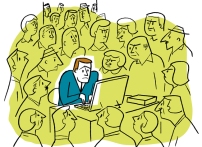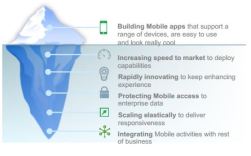“Our phone is increasingly our constant companion” – Dr. Theo Lynn.
With this quote Dr. Theo Lynn, Digital Marketing Programme Chairperson of DCU, opened the second DICE conference of this year: “Get Mobile”.
Dr. Theo Lynn, Digital Marketing Programme Chairperson of DCU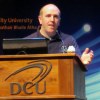
This simple but yet important truth brings many changes for society. Not only in the way we all interact in our everyday lives but also in the way marketing develops.
As nowadays 96% of Irish 18 to 35 year-olds have a smart phone they are no longer just a piece of technology, that makes our lives easier, they are moreover an essential part of our society. As about 94% of all smart phone users only use less than 10 apps however, competition is becoming increasingly more unforgiving for mobile marketers. Most apps either go viral or go nowhere at all.

“78% often compare the price of something online before buying an item in store.”
What companies have to realize and capitalize on though is that “Money follows eyeballs”. This means is that as we spend increasingly more time surfing the web via smart phones, more and more conversions are made through mobile technology; and even if a product is not bought on a smart phone, product research and purchase decisions are more and more often made on our “constant companion”.

The 4 Cs of Mobile.
So in order to keep up with the rapid changes in purchasing behavior and to capitalize most effectively on new technology, we need to rethink the way we do our marketing.
Dr. Mark Hughes, CEO of Digifeye
After Dr. Lynn’s introductory speech Dr. Hughes, CEO of Digifeye entered the stage, to give us an insight in what his company does and what makes them stand out from other companies.
It is Digifeye’s goal to provide a software solution, which is able to turn every imagery content to a shoppable content. This happens through an easy to implement omni-platform software, that detects products in videos, images and similar content and links existing shopping options to the content.
A quick snapshot of a t-shirt or a car can for example be processed by the Digifeye technology to list up shopping options of the photographed product, which can then be compared until a purchase decision is made.
The “traditional” way of processing pictures through keywords or “hash-tags” can therefore be replaced by an intelligent technology that works without manual information input. This also solves the problem of keyword searches not being adequate, as content is automatically processed and evaluated, without the risk of human errors.
With the rise of Google Glasses the potential of Digifeye’s way of linking imagery content with shopping options rises exponentially, as the amount of data that can be processed might increase dramatically. I personally am very interested in the future of this kind of image processing technology, as it not only has huge potential but also clear benefits for everyone, consumers as well as retailers and producers.
Dr. Cathal Gurrin, Computing Lecturer at DCU
The next speaker of the evening was Dr. Cathal Gurrin, Computing lecturer at DCU. He started his presentation with a question towards the audience: What does “mobile” even mean? The devices we use change every year. The brick a “mobile” phone used to be years ago has turned into a small computer, 60,000 times more powerful than the astronaut computer of Apollo 11. And even there the evolution of mobile devices does not stop: smart watches, Google glasses, implants,… nobody knows what possibilities await us. Today already we have phones that sense where we are, how we hold them, or who can even scan our finger prints.
One thing we do know for sure though is that the amount of user generated data will continually increase. We already have cameras for visual impressions, microphones for audio content and sensors for factors such as light or warmth. As our mobile devices become more and more omnipresent in our live a new kind of content starts to develop though: The “lifelog”. What this means is that our mobile devices will more and more become mobile memories that can save terrabytes of data every day, starting from the things we see, over the things we feel to things we might not even realize ourselves. Soon our devices might know more about us than we.
On the one hand side this kind of data storage creates wonderful opportunities for everyone: It can be used in the field of personal health, mitigation of memory losses through either forgetting things or through diseases such as Alzheimer’s disease. It can increase our security and our understanding of ourselves.
On the other side all this technology comes with a risk. How much might other people be able to know about ourselves? Does personal privacy really have such a low value to us that we make all our data accessible? Also a lifelog makes mass surveillance much more possible and a lot easier.
The question I asked myself when listening to Dr. Gurrin’s presentation was this one: “How far does society really want to progress in the technology of data collection and storage and how far should we go without sacrificing our own privacy and data security?”
Of course opportunities such as population wide market research, cross correlation checks and historical memory storage can provide huge benefits to our society, but at which costs?
All in all we can say that our mobile devices become more and more context aware, which might lead us in an era of life-logging and surrogate memories. This provides us with new challenges and opportunities. What we also need to consider is the impact of implantable devices and how they might contribute to said opportunities and challenges.
Eoin Cruise, Head of Microsoft Mobile Devices Ireland
After Dr. Gurrin, Eoin Cruise, the head of Microsoft Mobile Devices in Ireland entered the stage. Mr. Cruise has previously worked for Nokia, another well-known mobile phone brand that is at the moment integrating into Microsoft.
In his very honest speech he told us about how Nokia couldn’t establish in the smart phone section and how they struggled up to the point they just were not profitable anymore. Microsoft however now has acquired Nokia and integrated them in their mobile devices section to try to make them profitable for them again. This change is most easily seen in the name change of the last smart phone version of Nokia, the “Nokia Lumia” to “Microsoft Lumia” in the newer editions. The idea behind the new phones is to make a mobile platform that can run the same apps as Windows PCs and tablets, while still being user friendly and stylish.
At the moment Microsoft phones however hardly sell as other brands such as Samsung, Apple and Blueberry have way bigger market shares in the mobile section.
Paul Davey, Mobile leader at IBM
The first speaker after a short break was Paul Davey, IBM’s Mobile leader. Even though we might not see the logo of IBM all that often in our personal environment, we are constantly surrounded by IBM technology.
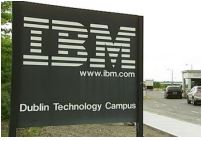
IBM has been having labs in Ireland for 50 years now.
As an example Mr. Davey showed us that in a flight from Dublin to London, we experience IBM technology at six different steps; from flight control technology, over parts of the airplane itself until automatic passport control stations. International Business Machines has been founded 103 years ago and has constantly grown. They even invented the first mobile device known as a smart phone. With more than 4,000 employees world-wide, IBM is a huge firm that has had laboratories in Ireland for more than 50 years now.
IBM’s newest project causing global discussions is called “Watson“. In it’s essence, Watson is a huge data base, that uses native language processing in order to find answers for every possible problem this world has to offer. The technology that stands behind it is extremely complicated to explain, the following video however gives a brief but detailed overview of how Watson works and what it can do:
“Watson” might quite possibly be the next big break through in problem solving technology, with applications in all kinds of different environments, such as health care, business, law and many more. It is the first step towards combining expertise all over the world and towards making it accessible all over the globe. One usage of “Watson” that is researched at the moment is it’s potential in fighting cancer, as “Watson” can combine patient’s personal information, symptoms, diagnoses etc. to find possible ways of treatment.
The next topic this presentation addressed was the programming and marketing of apps, as IBM at the moment works really close with Apple, in order to provide the background infrastructure their applications need.
The relation between Apple and IBM regarding apps can most accurately be metaphorized with an iceberg, as Apple creates all the content, design et cetera over the surface, while IBM provides the basis, which makes up for a way bigger part of said apps. Another new project, IBM developed to deal with the difficulties in the development of apps is called “Bluemix”
“Bluemix” makes it easier for developers to create apps, as it provides background hardware, a cloud service and a networking service. Therefore it is basically a platform on which apps can be developed and based.
Alex Meisl, Co-Founder of Sponge and Initiator of WiForia
Today’s last speaker was Alex Meisl, however his presentation was the longest of this conference. To start his speech Mr. Meisl presented us some shocking facts:
Alex Meisl.
“A third of all people interviewed would rather give up sex than smartphones.” – Alex Meisl
“More 5 year-olds know how to use a smart phone than how to tie their shoe laces” – Alex Meisl

World-wide there are more smart phones owned than tooth brushes.
These statistics highlight in a shocking way how important mobile devices have become, and how highly we value them. This especially shocked me, as I always figured that surviving without a smart phone might well be painful and annoying but I would not see my smart phone as such an important part of my life as my senses, my social circle or my sexuality.
He also threw the sentence in the room that “SMS is basically dead”, as free internet based services such as Whatsapp have taken their place instead. For me this was not so much of a new surprise, as i myself communicate with Whatsapp dozens of times more than with SMS or phone calls. However we were told that last year in the UK there were around 6.5 SMS per head and day sent in the United Kingdom, so therefore even though SMS might seem dead atleast for our age group, the still have a large share of mobile communication.
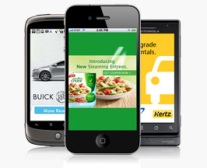
This year, mobile advertisement will be bigger than newspaper advertisement in the United Kingdom.
After providing us with those statistics, the first important topic was addressed: mobile advertising. The most astonishing controversy in the field of mobile advertisement at the moment is that even though apps are widely seen as “the future” in advertisement, 80% of all branded apps get less than 1000 downloads, which is almost nothing compared to apps going viral, such as Walmart’s app or the Argos app. What we have to take out of this is the problem that even though apps can create enormous amounts of revenue and brand recognition if done right, most brands do them wrong and therefore only achieve minor benefits.
The great difficulty of mobile apps indeed is “doing it right”. Which holds us back from success is mostly Fear, Uncertainty and Doubt as mobile marketing is still a very new field and most people have only little experience in this field, if any at all.
One first step towards successful mobile advertisement for most businesses might be creating a Google maps entry for said businesses, as most people nowadays use it to search for shops, as well as for navigation. Also creating such an entry is free, so there is basically no excuse for shops or firms that do not sign in.
The next step might be an optimized page for mobile devices, as websites that are not optimized for mobile surfing create less conversion and consumer interest. For most big companies a mobile page is essential, but most still do not have one.
Those two steps have the possibility of creating brand awareness, which is essential for businesses. To create customer awareness competitions or online coupons might be the optimal solution. One of the most popular examples of such competitions and coupons is McDonald’s with its Monopoly campaign. Also Harris&Hoole with their mobile loyalty card are a notable example of engagement creation via mobile marketing.
Mobile purchasing options such as the ones provided by Bacardi or Starbucks have also the potential to increase revenue and market shares. The biggest problem modern retailers are facing however lies in the creation of customer loyalty. As retailing services tend to become more and more anonymous, the need for a new way of creating customer loyalty rises. The problem with many non-mobile options that already exist, such as club cards, is that their impact is only really seen at the check-out, when purchasing decisions have already been made. To create more impact however the marketing leverage has to be applied much earlier. Free WiFi for customers is one way to make a positive impression, that is also very cost effective, as it is in most cases already used for the communication of store PC’s so all that needs to be done is to make it public.
Starbucks and Prêt-a-manger also have an interesting approach to award customer loyalty: A certain amount of their budget is used to randomly give away free coffees, which has a surprise factor on one hand side, and on the other side get’s people talking about it.
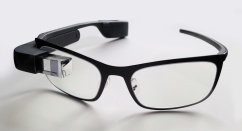
New devices such as Google glasses might further increase the potential of mobile marketing.
All the above mentioned options make a good impression on customers and therefore can help businesses to achieve their goals. Mobile marketing offers many ways to improve existing marketing methods in a interesting, intuitive and successful way. Devices such as smart watches, Google glasses and augmented reality devices might push the possibilities even further, maybe in a way nobody realizes yet.
All in all today’s conference was a real eye-opener towards technological advances and possibilities as well as towards the application of marketing theory on our everyday’s lives. Also the field of mobile marketing sounded way more interesting and diverse with the words and knowledge of “insiders” than it appears for laypersons such as me on a daily basis.
I look really forwards to the next conference, as both of the last conferences not only were very interesting to attend, but also provided important take-aways for me, that might quite possibly influence the way I see and experience marketing in the future.
For further Information follow and updates please follow me on Twitter and Facebook.






